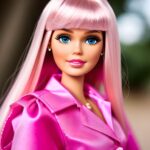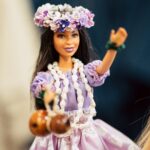
Are you curious to know how Barbie stacks up against other popular toy dolls when it comes to sales and popularity? Well, you’ve come to the right place! In this article, we will explore the fascinating world of toy dolls and examine how Barbie, the iconic doll, compares to its competitors. With its undeniable presence in the toy industry for decades, Barbie has captured the hearts of children and collectors alike. But does Barbie reign supreme, or are there other dolls that give her a run for her money? Let’s find out!

This image is property of images.unsplash.com.
Historical Overview of Barbie
Introduction of Barbie in 1959
Barbie, the iconic doll that has captured the hearts of millions, was first introduced to the world in 1959 by Mattel, a leading toy manufacturing company. Created by businesswoman Ruth Handler, Barbie was named after Handler’s daughter, Barbara. The doll was initially intended to provide an alternative to the baby dolls that dominated the market, with a focus on fostering imagination and encouraging girls to dream big.
Expansion of Barbie’s product line
Since its inception, Barbie has evolved to become more than just a doll. Over the years, Mattel has expanded Barbie’s product line to include an array of accessories, playsets, and themed collections. From dream houses to fashion sets, the options are endless for children to immerse themselves in Barbie’s world. This expansion has allowed Barbie to stay relevant in an ever-changing toy industry, captivating the hearts and minds of children around the globe.
Introduction of diverse Barbie dolls
In recent years, Barbie has made significant strides towards inclusivity and representation. The introduction of diverse Barbie dolls that reflect a range of ethnic backgrounds, body types, and abilities has been a major step forward. This move has been applauded by many as a positive shift towards a more inclusive toy industry, as it allows children to see themselves represented in their toys and promotes diversity and acceptance from an early age. Barbie’s commitment to diversity has further solidified her presence as a timeless and beloved toy.
Competitors in the Toy Doll Industry
Bratz Dolls
One of Barbie’s most notable competitors is the Bratz dolls. Launched by MGA Entertainment in 2001, these dolls quickly gained popularity for their edgy and fashion-forward style. Bratz dolls offered a unique alternative to Barbie with their large heads, pouty lips, and trendy outfits. The dolls resonated particularly well with tweens and pre-teens, who embraced their bold and contemporary image. However, despite their initial success, Bratz dolls faced some legal battles and controversies over the years, impacting their overall presence in the market.
American Girl Dolls
American Girl dolls, introduced in 1986, carved a niche for themselves in the toy doll industry by focusing on historical characters and storytelling. These dolls represent different periods of American history, allowing children to engage with educational narratives and themes. The combination of quality craftsmanship, detailed storytelling, and an emphasis on empowering young girls has set American Girl dolls apart from other competitors. The brand has managed to build a loyal following and has continued to expand its product line with accessories, books, and even a magazine.
Monster High Dolls
In 2010, Mattel introduced Monster High dolls to cater to a younger demographic seeking a more unconventional and fantastical doll experience. These dolls incorporate elements of horror and fantasy, featuring characters inspired by monsters and creatures from folklore. The unique appeal of Monster High dolls lies in their distinctive aesthetics and elaborate backstories, which allow children to engage in imaginative play while exploring themes of diversity and inclusion.
Disney Princess Dolls
As pioneers in storytelling and animation, Disney has capitalized on the popularity of its princess characters by creating a line of dolls based on these beloved characters. From Cinderella to Elsa, children can recreate their favorite Disney princess moments with the corresponding dolls. Disney Princess dolls have thrived by leveraging their connection to classic films and fairy tales, providing a sense of nostalgia and familiarity. The Disney brand’s vast reach and marketing power have contributed to the success of these dolls.
Sales and Revenue Comparison
Barbie’s annual sales figures
Barbie’s sales figures have consistently remained strong since its introduction. In 2019, Barbie generated approximately $1.1 billion in sales revenue worldwide. Despite facing competition from various doll brands, Barbie has managed to maintain a significant market share and remains one of the top-selling dolls globally.
Comparison of Barbie’s sales with competitors
When comparing Barbie’s sales to its competitors, it becomes evident that Barbie’s longevity and brand recognition continue to play a significant role in its success. While Bratz dolls experienced a surge in popularity in the early 2000s, their sales have since declined. American Girl dolls have maintained a steady presence in the market but have a more niche target audience. Monster High dolls have also seen a decline in sales in recent years. Disney Princess dolls, on the other hand, have proven to be strong contenders for Barbie, leveraging their association with beloved characters and movies. However, Barbie’s continued innovation and efforts towards inclusivity have helped maintain its competitive edge.
Factors Contributing to Barbie’s Popularity
Brand Recognition and Longevity
Barbie’s enduring popularity can be attributed in large part to its strong brand recognition and longevity. Barbie has been a household name for over six decades, standing the test of time by constantly reinventing itself to meet the changing demands of the market. Its presence in popular culture, countless collaborations, and the iconic Barbie logo have all contributed to the enduring appeal of the brand.
Appeal to a wide range of demographics
Barbie’s ability to appeal to a wide range of demographics has been instrumental in its popularity. With its extensive product line and diverse doll offerings, Barbie caters to various age groups, interests, and backgrounds. From fashion enthusiasts to aspiring scientists, Barbie dolls and playsets can be tailored to suit individual preferences. This versatility ensures that Barbie remains inclusive and accessible to children worldwide.
Marketing strategies and collaborations
Mattel’s marketing strategies and collaborations have played a crucial role in sustaining Barbie’s popularity. Over the years, Barbie has collaborated with renowned designers, celebrities, and influential figures to create limited-edition dolls that captivate collectors and fans alike. Additionally, Mattel’s marketing campaigns have highlighted Barbie’s positive attributes, encouraging imagination, self-expression, and empowerment. These efforts have helped maintain Barbie’s status as a leading toy brand.

This image is property of images.unsplash.com.
Criticism and Controversies Surrounding Barbie
Body image issues and unrealistic beauty standards
One of the most significant criticisms leveled against Barbie over the years has been the doll’s portrayal of an unrealistic and disproportionate body image. With her slender figure, long legs, and tiny waist, Barbie has been accused of promoting unhealthy beauty standards and contributing to negative body image among young girls. The unrealistic physique of the doll has sparked debates about body diversity and the impact of media and toys on children’s self-esteem.
Lack of diversity
Another area of criticism aimed at Barbie has been the lack of diversity in its early years. For a long time, Barbie dolls predominantly featured Caucasian features and did not represent the full spectrum of ethnicities and races. This lack of diversity failed to provide representation for children from different cultural backgrounds, reinforcing the notion of a beauty ideal that didn’t reflect the reality of a multicultural society. This criticism prompted Mattel to take significant steps towards diversifying Barbie’s range of dolls and providing greater representation in their product offerings.
Gender stereotypes
Barbie has also faced criticism for perpetuating gender stereotypes through her various career-themed dolls and playsets. Critics argue that Barbie’s focus on traditionally feminine roles, such as fashion and homemaking, limits the aspirations of young girls and reinforces gender norms. However, it is essential to note that Barbie’s product line has expanded to include dolls pursuing various careers, aiming to break down these stereotypes and empower children to explore different paths.
Barbie’s Response to Criticism
Introduction of diverse dolls and body types
In response to the criticism and calls for greater inclusivity, Mattel took significant steps to diversify Barbie’s range of dolls. In 2016, the brand introduced the Fashionistas line, featuring dolls with various body types, skin tones, and hairstyles. This initiative aimed to promote body positivity and cater to a broader range of girls, ensuring that every child can find a doll that reflects their unique identity.
Partnerships promoting inclusivity and empowerment
Barbie has also partnered with various organizations and initiatives committed to promoting inclusivity and empowerment. Collaborations with influential figures like Misty Copeland, the first African American principal ballerina, and Ashley Graham, a plus-size model, have showcased diverse role models and sent a powerful message of acceptance and self-love. By aligning with these figures, Barbie has shown its commitment to fostering positive self-image and inspiring children to dream without limitations.

This image is property of images.unsplash.com.
Impact of Barbie on Society and Culture
Influence on fashion and popular culture
Barbie’s influence on fashion and popular culture cannot be overstated. From her wide-ranging wardrobe to her ever-evolving style, Barbie has inspired countless trends and served as a muse for designers, photographers, and artists. The doll’s impact reaches beyond the toy industry, permeating the worlds of fashion, beauty, and even art exhibitions. Through her fashion choices, Barbie has encouraged creativity and self-expression, becoming an iconic symbol of style and glamour.
Impact on children’s perception of beauty and femininity
As one of the most recognizable dolls in the world, Barbie inevitably influences children’s perception of beauty and femininity. The doll’s early emphasis on a narrow beauty ideal sparked debates about body image and instilled certain expectations in young girls. However, the introduction of diverse dolls with various body types has allowed Barbie to become more representative of real-world beauty, celebrating different interpretations of femininity and broadening children’s perspectives.
Barbie as a symbol of empowerment
While Barbie has faced criticism over the years, she has also been embraced as a symbol of empowerment for many. The doll’s extensive range of careers and characters encourages girls to dream big and imagine themselves in diverse roles. By showcasing women in traditionally male-dominated fields like STEM and sports, Barbie challenges stereotypes and sends a powerful message that girls can pursue any avenue they desire. Barbie has become a symbol of empowerment and resilience, inspiring generations of girls to break free from societal limitations and strive for success.
Recent Developments and Future Outlook
Introduction of career-oriented dolls and playsets
In recent years, Barbie has expanded its focus on career-oriented dolls and playsets, providing children with endless possibilities for imaginative play and exploration. From doctors to astronauts, Barbie offers a range of dolls that expose children to various career paths and aspirations. This focus on career exploration allows children to envision themselves in different roles and encourages them to pursue their dreams.
Expansion into digital platforms and online content
Recognizing the shifting landscape of entertainment, Barbie has expanded her presence into digital platforms and online content. The Barbie website offers interactive games, videos, and activities that engage children in educational and imaginative play. Additionally, Barbie has ventured into the world of social media, utilizing platforms like Instagram and YouTube to connect with her audience and provide content that promotes creativity and inclusivity.
Looking ahead, Barbie is set to continue evolving and adapting to the changing needs and desires of children. With its commitment to inclusion, representation, and empowerment, Barbie aims to inspire future generations to dream big and embrace their full potential.
In conclusion, Barbie holds a prominent place in the world of toys, drawing children into her magical world of imagination and creativity. With its rich history, diverse product line, and commitment to inclusivity, Barbie has become more than just a doll. She is a symbol of empowerment, breaking stereotypes, and embracing individuality. Despite facing competition from various doll brands, Barbie’s enduring popularity prevails, making her an iconic and cherished toy across generations.










